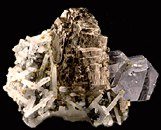|
|
| Formula: | Fe0.9S |  Click to see a larger image |
||
| Crystal: | Hexagonal | |||
| Hardness: | 3.5-4.5 | |||
| Spec. Gr.: | 4.6-4.7 | |||
| Streak: | black, dark grayish | |||
| Cleavage: | N/A | |||
| Location: | Dal'negorsk, Promorsky Krai, Russia |
|
"Pyrrhotite is a common reddish-brown to brownish-bronze hexagonal mineral: Fe1-xS. It has a defect lattice in which some of the ferrous ions are lacking [hence the Fe1-xS]. Pyrrhotite is attracted by the magnet... it is usually found massive and commonly associated with pentlandite, often containing as much as 5% nickel, in which case it is mined as a valuable ore of nickel," (see Bibliography 1). The name is from the Greek word PYRRO'S (fire). Pyrrhotite occurs as a high-temperature sulfide, tends to be unstable and is often replaced by pyrite, arsenopyrite and marcasite in remarkable pseudomorphs. Fine crystals have come from Freiberg, Germany; Herja, Romania; Bottino, Italy; and at Dal'negorsk, Russia. Pyrrhotite crystals are relatively rare, most often occurring as hexagonal plates. It has a brownish-bronze color, is brittle, has a gray-black streak, is magnetic, and is a good electrical conductor. |
|
Bibliography: 1. American Geological Institute, Glossary of Geology, 1972, pg. 508. Svenek, Jaroslav, Minerals, 1987, pp. 56-57. |
|
University of California, Santa Barbara—Department of Earth Science Copyright © 2005 Regents of the University of California Send your comments to the Web Page Editor |